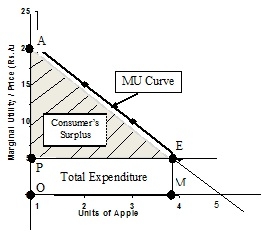The concept:
--------------
The concept of consumer`s surplus was first introduced by Alfred Marshall.
When a consumer is prepared to buy a commodity, he always calculates the utility he is going to derive from its consumption.
Every rational consumer compares the utility he derives from the consumption of a commodity, against the price he has to pay. If the utility is more than the price paid, he prefers it and if it is vice-versa, he does not buy the same good.
The surplus of utility he derives is consumer’s surplus.
In nutshell, consumer`s surplus is the difference between what the consumer is willing to pay and what he actual pays.

Consumer`s surplus is experienced in commodities which are highly useful but relatively cheap. For example, newspaper, salt, match box, postage stamp etc. For these commodities, we are ready to pay more than what we actually pay.
Marginal utility explains the price which a consumer is willing to pay for the unit of the commodity. As more and more units of a commodity is purchased, the marginal utility declines. Therefore the price, which the consumer is willing to pay, also decreases. Thus, the difference between marginal utility and the market price (actual price) also gives the consumer`s surplus.


